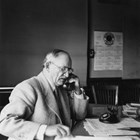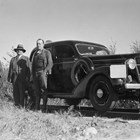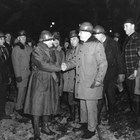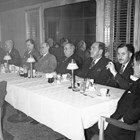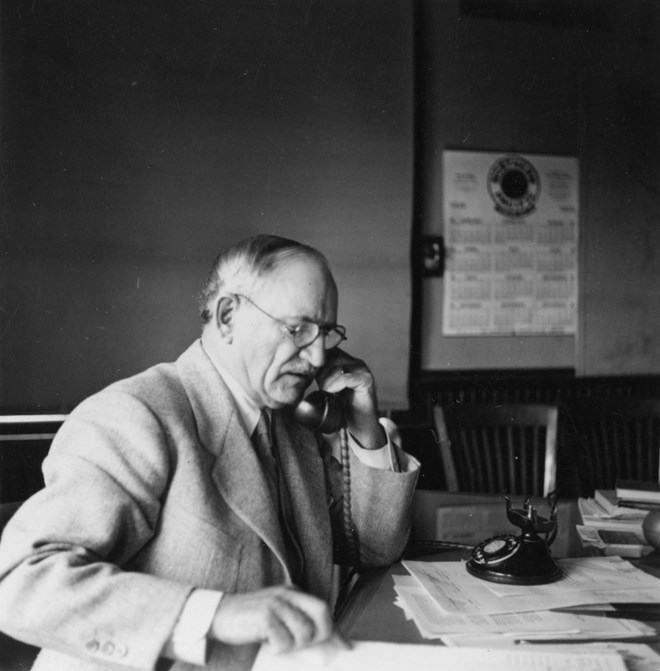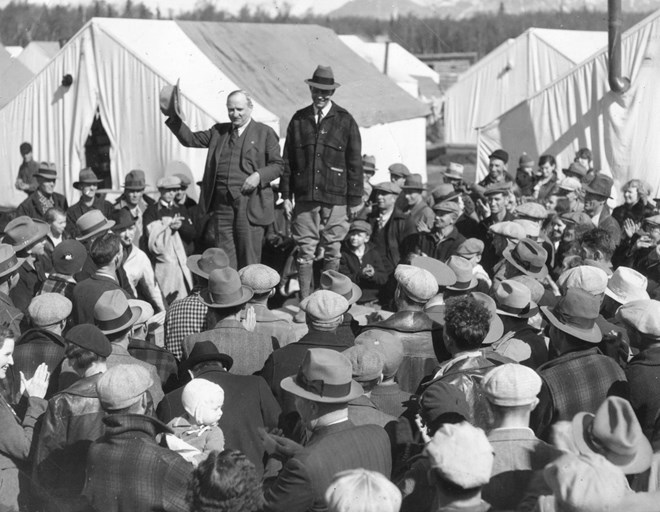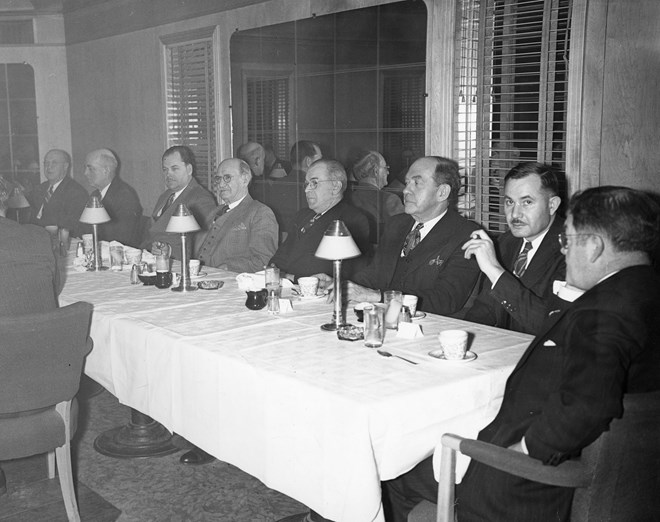Ohlson, Otto F.
1870-1956 | General Manager, Alaska Railroad
The general manager with the longest service with the Alaska Railroad was Otto Ohlson. His employment began in August 1928 and continued through World War II, ending in 1945. In 1942, when World War II came to Alaska, the Alaska Railroad was materially sound and a model of sound management. When the Japanese attacked the Aleutian Islands in 1942, it became obvious that a major military campaign would be required. Ohlson was proven right that his no-nonsense administrative techniques were the best way to run a railroad. Historian Stephen Haycox gave this evaluation: "He was the right man for a tough job at the right time, and with his stubborn determination, made a monumental contribution to the growth and development of Alaska, and the health and stability of its major city. . . . And profits from hauling military equipment and supplies grew so handsome during the war as to be an embarrassment. In the meantime, Anchorageites would only fume, and then, as Ohlson proved right in his policies, simply stand back in awe and wonder."1
For seventeen years, Ohlson was the general manager of the Alaska Railroad and arguably the most powerful man in Alaska. In 1929, when the Alaska Territorial Governor George A. Parks was paid $7,000 a year, Ohlson was paid $14,400.2 Ohlson has been described by historians as a “quick-tempered, energetic man” who was “autocratic and flamboyant;”3 as a “czar,” “stubborn” and “crusty;”4 as “tenacious” and “cantankerous,”5 and a “dictator.”6 Ohlson’s contemporary and frequent critic, Anchorage Daily Times editor Robert Atwood, called him “vindictive” and “stern,” a “dictator” who at times “stood in the way of progress,”7although the two found themselves allies in projects like the Matanuska Valley Colony.8
Ohlson’s superiors in the U.S. Department of the Interior, both Democratic and Republican, who were concerned about reducing the Alaska Railroad’s annual deficit and the efficient operation of the system, valued his frugality. No one could question his dedication to the Alaska Railroad. An energetic administrator, Ohlson learned the railroad inside out, often traveling from point-to-point in his DeSoto sedan which was equipped to run on the railroad tracks.
Before World War II, the Alaska Railroad was the primary economic foundation of the Anchorage economy. Completed over an eight-year period (1915-1923), the Alaska Railroad cost $65 million, almost twice the original amount in federal appropriations earmarked for its construction.9 Historians have characterized Alaska’s economic history as a series of booms and busts. In Anchorage, the railroad construction boom period ended in 1923 when 580 miles of standard gauge railroad were completed and President Warren G. Harding came to Alaska and drove the symbolic “golden” spike near Nenana on July 15, 1923. There were hard times in Anchorage when the anticipated economic boom following the railroad’s completion did not materialize. The inevitable bust of the mid-1920s would continue into the mid-1930s, until significant federal aid in the form of New Deal programs such as the Matanuska Valley Colony project were implemented in Alaska. The impact of the Depression of the 1930s was not solved until the massive federal military build-up in 1939-1940, leading to America’s entrance into World War II, transformed Alaska’s economy.10 World War II brought large profits to the Alaska Railroad from transporting civilian and military supplies and materials.
Early Life and Railroad Career
Otto Frederick Ohlson was born on June 6, 1870 in Halmstadt, Sweden. He was schooled at the Electric Technique in Stockholm, completing his coursework in 1890. He worked in South Africa and East India as either an electrician or a telegrapher before joining the Pennsylvania Railroad in 1893. He worked as a telegrapher and then as assistant trainmaster until 1901, when he left the Pennsylvania Railroad for the Northern Pacific.11
On September 7, 1898, Ohlson married Marie E. Ricketts in Hennepin, Minnesota.12 He became a United States citizen while living in Franklin County, Ohio on March 10, 1899.13 In 1901 he began working for the Northern Pacific Railroad, working his way up from operator, telegrapher, station agent, train dispatcher, train master, and finally as superintendent of both the Yellowstone Division and the Lake Superior Division at Duluth.14
During World War I, Ohlson joined the American Expeditionary Force and saw service as the general superintendent of United States railroads in France, with the rank of lieutenant colonel, which he retained in the reserve corps. His experience with train operations in France in 1918-1919 was an advantage in his administration of the Alaska Railroad during World War II.15
In December 1919, Ohlson returned to the Northern Pacific Railroad. His abilities came to the attention of a federal government official, possibly the vacationing President Calvin Coolidge. In 1928, Ohlson was offered the position of general manager of the Alaska Railroad. Ohlson was well qualified for the position, as he already had a twenty-seven year career in railroading, was a Republican, and Alaska could not faze him.16
General Manager of the Alaska Railroad (1928-1945)
On taking over management of the Alaska Railroad in 1928, Ohlson was faced with numerous problems. The railroad was being run at a deficit, although Ohlson’s predecessor, Noel W. Smith, had brought it down substantially.17 It was difficult for the railroad to generate enough business to make a $65 million railroad profitable since the population of the Alaska railbelt remained small. In 1930, the three largest towns of Seward, Anchorage, and Fairbanks had a combined population of 5,400 people.18 Although there was gold mining in the Willow Creek and Fairbanks areas, and coal mining near Palmer and at Healy, there was relatively little freight for the railroad to carry. Maintenance costs were high because of the use of inferior materials during the construction of the railroad. The severe climate necessitated constant repairs, as did the disruption of the roadbed due to avalanches and landslides in the mountainous Kenai Peninsula and to the action of permafrost along the northern section of the line. Ohlson continually struggled to reduce operating costs, to improve the roadbed (which he justified because it would reduce maintenance costs), and to maintain aging equipment.
Within two years of arriving at his new post, Ohlson closed the narrow gauge Chatanika spur line that supplied mining operations near Fairbanks. The Steese Highway, which paralleled the spur line, drained freight and passengers from the railroad. The expenses to run the spur line were nearly four times the income generated. Despite the protests of local residents, Ohlson closed the line. As historian William H. Wilson expressed it, “The Railroad wanted by so few was quickly forgotten by many.”19
Shortly after Ohlson became general manager, the Alaska Railroad was investigated by a U.S. congressional committee in 1930 chaired by Senator Robert B. Howell of Nebraska. Howell had been to Alaska in 1923 with President Warren G. Harding’s party during the opening of the railroad. He was a constant critic of the railroad’s operation and, in particular, the railroad’s operating deficits.20 He believed that the railroad line from Seward to Anchorage should be abandoned as too expensive to operate. Howell reiterated his view that the railroad should terminate at Nenana, where riverboats could carry freight further into the Alaska interior.21 While he backed off those recommendations in the final report, his demand that freight and passenger rates be increased were accepted. Ohlson was tasked by his superiors to raise rates and to reduce the deficit. Howell also recommended that the Alaska Railroad sharply curtail the number of trains it ran, thereby creating savings on labor and equipment. In 1930 the trains ran a total of 262,651 miles; in 1933 they ran 90,727.22
When the Howell Report was completed in 1930, it called for the abandonment of some track, a decrease on the amount of traffic on the rails, an increase in freight and passenger rates, and strict attention to economy and efficiency. Ohlson agreed with the recommendations, and implemented these austerity measures which the committee insisted was the price to be paid for keeping the railroad open.23
Ohlson cut staffing. During Noel Smith’s last year as general manager of the railroad there were 934 employees (many of them seasonal). In 1931, Ohlson had reduced this figure to 671 employees; in 1933, it went down further to 650 employees.
As a result of the Howell Report, freight and passenger rates for the railroad were increased sharply. Passenger rates increased nearly sixty-seven percent, shocking the residents of the railbelt. It was expected that the new rates would result in additional revenue for the railroad. Instead, local residents avoided the railroad whenever possible and revenues actually declined.24 The cost of consumer goods increased, raising local ire, and the railroad deficit went up rather than down. Within a short time Ohlson was authorized to drop rates in an attempt to increase usage of the railroad.
During Ohlson’s early years with the Alaska Railroad, he railed against the competition for freight caused by truckers using the Richardson Highway north out of Valdez. Freight, particularly perishables being shipped to Fairbanks, would arrive on the highway sometimes a day earlier than they would on the railroad. Merchants preferred to use truckers, whose rates were often less than the Alaska Railroad. Ohlson attempted to get the southern portion of the Richardson Highway closed, which he felt would increase Alaska Railroad revenues as freight would no longer be carried on the Richardson. In 1935, when the Alaska Road Commission came under the Department of the Interior, Ohlson successfully lobbied for an increase in the ferry rates across the Tanana River at what is now the community of Big Delta, then McCarthy. Truckers took to sending their goods across the river on a scow, then crossing with their trucks on the ferry at a much reduced rate. They would load up on the other side and then proceed to Fairbanks. Later the truckers even took over the ferry by force and used it for a short time for free. A federal deputy marshal sent to stop the takeover was locked away. A Fairbanks grand jury would not indict those who took over the ferry. The tolls were removed.25 As a result of Ohlson’s attempt to reduce truck traffic, Alaska’s representative in Congress, Anthony Dimond, unsuccessfully demanded Ohlson’s removal.26
Ohlson realized that the Alaska Railroad’s fiscal situation would improve if the population of the railbelt increased and subsequently freight increased. Soon after arriving he wrote a pamphlet, later titled Alaska, the Newest Homeland, extolling the agricultural potential of the Fairbanks and Tanana areas, and the Matanuska Valley. In 1929 he hired the former head of the U.S. governmental experimental farm in the Matanuska Valley, M.D. Snodgrass, to encourage homesteaders to move north. As many as 110 people or families did move north to establish homesteads in the railbelt, although not all of them stayed. The Alaska Railroad offered special reduced freight rates to settlers and their goods, and Ohlson also negotiated reduced rates for settlers on Alaska Steamship Company ships. Ohlson felt there would be a market for what the homesteaders grew or raised, estimating in 1934 that Anchorage alone would consume $270,000 worth of food annually that could be raised in Alaska. By 1934 there were 117 homesteads in the Matanuska Valley and Anchorage area.27
In 1935, the federal New Deal Matanuska Valley Colony project brought 202 families from economically-depressed northern counties in Michigan, Minnesota, and Wisconsin to start new farms in the Matanuska Valley. This project was an extension of a program that was attempted in several states. It was brought to Alaska to encourage agricultural self-sufficiency and to encourage new migration to the territory.28 Ohlson was an enthusiastic supporter and helped plan the project as it meant more passengers and freight. When the families arrived in Anchorage he walked down the train, shaking the colonists’ hands. He became a member of the Board of Directors of the Alaska Rural Rehabilitation Corporation, which supervised the project, and finally its chairman.29
In 1934, and again in 1936, Ohlson was instrumental in supplying Alaska during major longshoremen’s strikes in Seattle. These strikes posed a great hardship to Alaskans, most of whom were reliant on regular supplies of food brought north by steamship and then hauled inland by the railroad or by truck. In 1934, Ohlson reached a compromise with the strikers that allowed shipments to be made from Tacoma at a higher freight charge. In fall 1936 during a second strike on the Seattle docks, Ohlson contracted with several ships to carry supplies to Alaska.30
Deficits continued to decline through fiscal year 1938, when revenues exceeded expenses for the first time. Under the management of Otto Ohlson, the Alaska Railroad had its first profitable year in 1938. Gradually, time and a shrewd and belligerently capable general manager had slowly accomplished an operating and financial miracle. From 1938 onward, Congress never had to appropriate funds for operations.31
By 1940 the U.S. military was establishing itself along the rail line, and Ohlson had new problems. During the war years Ohlson had trouble locating good employees as workers were drafted or left for higher paying jobs on the new military bases or the factories in the Lower forty-eight states. Ohlson finally had to accept the services of the thousand-man 714th Transportation Corps Railway Operating Battalion to help operate the railroad. Although this helped, the men of the 714th did not provide needed “car repairmen, machinists, boilermakers, and blacksmiths.”32 Another fifty soldiers were detailed to mine coal for operating the trains and keeping the new bases (as well as the civilian community) warm in the winter. Civilian employees brought to Alaska to work on the railroad often proved useless. Train mileage shot up as the railroad was used to haul coal and military freight, and the roadbed and rolling stock deteriorated more quickly. The result was more derailments as track and railbed declined.33 The U.S. Army improved the docks at Seward and helped rebuild sections of the line.34
Ohlson’s dream of building a spur line to Whittier on Prince William Sound to provide access to an ice-free port near Anchorage was realized when the Whittier cut-off was completed in the spring of 1943. When the project was completed, the Alaska Railroad handled seventy-five percent more freight traffic with existing equipment and moved military traffic without serious restrictions to civilian supplies.35
Two long tunnels, one over 13,000 feet long and the fourth longest railroad tunnel in the United States, were built through the Chugach Mountains to allow rail access to Whittier. Located east of Seward at the head of the Passage Canal on Prince William Sound, the port of Whittier was used by the U.S. Army as a second seaport railroad terminal to handle increased tonnages of war materials and equipment that were shipped to Alaska and to provide an alternate port to Seward. In 1941, work was started on two railroad tunnels, the laying of a 14-mile railroad track from Portage to Whittier, and the construction of a terminal on Passage Canal. The shorter tunnel (Moraine Tunnel), 4,910 feet long, was on the west side of project close to the moraine of nearby Portage Glacier. The second tunnel (Whittier Tunnel), 13,090 feet long, had an outlet near the Whittier Glacier. Bear Valley is between the two tunnels. The two tunnels provided a railroad linkage between the Army’s port at Whittier and the Alaska Railroad’s line at Portage, south of Anchorage. The rail line to Whittier shortened the distance from tidewater to Anchorage and Fairbanks by 51.5 miles and gave the Alaska Railroad a second terminal rail connection for ocean-going vessels. The $11 million port project included docks, a power plant, rail yards, warehouses, and housing. With the rail cutoff in operation, the port of Whittier handled the military traffic; Seward handled the commercial traffic. Because of ventilation problems, the Alaska Railroad’s first diesel locomotives were purchased to make the Whittier runs through the tunnels.36
Aftermath
When World War II ended in 1945, Ohlson was seventy-five years old and exhausted. His wife, Marie Ricketts Ohlson, died of a heart attack in 1939.37 Over the years he had become more cantankerous and querulous. Toward the end of his tenure at the Alaska Railroad he had become so frustrated with a union bargaining agent that he attempted to strangle the man during a union negotiation.38 In 1945, Ohlson stepped down as general manager.
He initially had a position in southeast Alaska as a receiver for a failed sawmill, but then moved to Seattle where he lived for several years. He traveled on a world tour in 1950 and made his final home in northern Virginia, where he died on his birthday, June 6, 1956. He is interred at the Hampton National Cemetery in Hampton, Virginia.39
Endnotes
1. Stephen Haycox, “Colonel Otto Ohlson: Federal Czar in a Railroad Town,” A Warm Past: Travels in Alaska History (Anchorage: Press North, Inc., 1988), 149-151.
2. Entry for Otto F. Ohlson, Official Register of the United States, Containing a List of Persons Occupying Administrative and Supervisory Positions in Each Executive and Judicial Department of the Government, Including the District of Columbia (Washington, DC: Government Printing Office, 1929): 61, U.S., Register of Civil, Military and, Naval Service, 1863-1959 [database on-line], http://ancestry.com (accessed January 22, 2015).
3. Elizabeth Tower, Anchorage: From Its Humble Origins as a Railroad Construction Camp, City History Series (Fairbanks: Epicenter Press, 1999), 76-80.
4. Stephen Haycox, A Warm Past: Travels in Alaska History, 149-151.
5. William H. Wilson, Railroad in the Clouds: The Alaska Railroad in the Age of Steam, 1914-1945 (Boulder, CO: Pruett Publishing Company, 1977), 195-196.
6. Evangeline Atwood, Anchorage: All-America City (Portland, OR: Binfords & Mort, 1957), 24-25.
7. Bob Atwood, Bob Atwood’s Alaska: The Memoirs of a Legendary Newspaper Man (Anchorage: Marilaine Publishing, Inc., 2003), 15-17.
8. Ibid., 18.
9. Claus-M. Naske and Herman E. Slotnick, Alaska: A History, Third Edition (Norman: University of Oklahoma Press, 2011), 160-161; and Stephen Haycox, A Warm Past: Travels in Alaska History, 149.
10. Terrence Cole, Banking on Alaska: The Story of the National Bank of Alaska, Volume 1: A History of NBA (Anchorage: National Bank of Alaska, 2000), 131; Stephen Haycox, Alaska: An American Colony (Seattle: University of Washington Press, 2002), 236 and 248; and Claus-M. Naske and L.J. Rowinski, Anchorage: A Pictorial History (Norfolk, VA: Donning Company, Publishers, 1981), 104-105.
11. William H. Wilson, Railroad in the Clouds: The Alaska Railroad in the Age of Steam, 1914-1945, 195.
12. Entry for Otto Ohlson and Marie Ricketts, Minnesota, Marriage Index, 1849-1950 [database on-line], http://ancestry.com (accessed January 21, 2015).
13. Evangeline Atwood and Robert DeArmond, Who’s Who in Alaska Politics: A Biographical Dictionary of Alaskan Political Personalities, 1884-1974 (Portland, Oregon, Binfort & Mort, 1977), 74.
14. Application, Otto Frederick Ohlson, File No. 19923, Box 119, U.S., Northern Pacific Railway Company Personnel Files, 1890-1963 [database on-line], http://ancestry.com (accessed September 26, 2015); William H. Wilson, Railroad in the Clouds: The Alaska Railroad in the Age of Steam, 1914-1945, 195; and Ed Ferrell, compiler and editor, Biographies of Alaska-Yukon Pioneers, 1850-1950, Volume 4 (Bowie, MD: Heritage Books, Inc., 2000), 245.
15. William H. Wilson, Railroad in the Clouds: The Alaska Railroad in the Age of Steam, 1914-1945, 195; and Lyman L. Woodman, Duty Station Northwest: The U.S. Army in Alaska and Western Canada, 1867-1987, Volume Two: 1918-1945 (Anchorage: Alaska Historical Society, 1997), 7.
16. William H. Wilson, Railroad in the Clouds: The Alaska Railroad in the Age of Steam, 1914-1945, 195.
17. Ibid., 180.
18. The Alaska Railroad: Historical Summary (Anchorage: Alaska Railroad, 1985), 4.
19. William H. Wilson, Railroad in the Clouds: The Alaska Railroad in the Age of Steam, 1914-1945, 198.
20. Ibid., 197.
21. Ibid., 198.
22. Ibid., 203.
23. Stephen Haycox, A Warm Past: Travels in Alaska History, 149-150.
24. Ibid., 202.
25. Ibid., 212.
26. Elizabeth Tower, Anchorage: From Its Humble Origins as a Railroad Construction Camp, 78.
27. Orlando W. Miller, The Frontier in Alaska and the Matanuska Colony (New Haven, CT: Yale University Press, 1975), 28-39.
28. Stephen Haycox, Alaska: An American Colony, 249-250; and Claus-M. Naske and Herman E. Slotnick, Alaska: A History, 169-171.
29. Ibid., 110-111.
30. William H. Wilson, Railroad in the Clouds: The Alaska Railroad in the Age of Steam, 1914-1945, 227-229.
31. The Alaska Railroad: Historical Summary (Anchorage: Alaska Railroad, 1985), 1 and 4.
32. William H. Wilson, Railroad in the Clouds: The Alaska Railroad in the Age of Steam, 1914-1945, 259.
33. Ibid., 260.
34. Ibid., 261.
35. Edwin M. Fitch, The Alaska Railroad (New York: Frederick A. Praeger, Publishers, 1967), 86-87.
36. Lisa Mighetto and Carla Homstad, Engineering in the Far North: A History of the U.S. Army Engineer District in Alaska (Fort Belvoir, VA: U.S. Army Corps of Engineers, 1997), 64-68; U.S. Army Corps of Engineers Digital Library,
http://cdm16021.contentdm.oclc.org/cdm/ref/collection/p16021coll4/id/101 (accessed September 27, 2015).
37. “Death Strikes Down Mrs. O. F. Ohlson,” Anchorage Daily Times, April 14, 1939, 1.
38. William H. Wilson, Railroad in the Clouds: The Alaska Railroad in the Age of Steam, 1914-1945, 261.
39. Otto Frederick Ohlson, Section F, Site 1110, Hampton National Cemetery, Hampton, Virginia, U.S. National Cemetery Administration, U.S. Department of Veterans Affairs, http://gravelocator.cern.va.gov/index.html (accessed September 27, 2015).
Sources
This biographical sketch of Otto F. Ohlson is based on an essay originally published in John Bagoy’s Legends & Legacies, Anchorage, 1910-1935 (Anchorage: Publications Consultants, 2001), 303-305. See also the Colonel Otto F. Ohlson file, Bagoy Family Pioneer Files (2004.11), Box 6, Atwood Resource Center, Anchorage Museum at Rasmuson Center, Anchorage, AK. Note: revised, expanded, and updated by Bruce Parham and Walter Van Horn on September 15, 2015.
Preferred citation: Bruce Parham and Walter Van Horn, “Ohlson, Otto F.,” Cook Inlet Historical Society, Legends & Legacies, Anchorage, 1910-1940, http://www.alaskahistory.org.
Major support for Legends & Legacies, Anchorage, 1910-1940, provided by: Anchorage Museum at Rasmuson Center, Atwood Foundation, Cook Inlet Historical Society, and the Rasmuson Foundation. This educational resource is provided by the Cook Inlet Historical Society, a 501 (c) (3) tax-exempt association. Contact us at the Cook Inlet Historical Society, by mail at Cook Inlet Historical Society, Anchorage Museum at Rasmuson Center, 625 C Street, Anchorage, AK 99501 or through the Cook Inlet Historical Society website, www.cookinlethistory.org.
